The world of Hara is dying—the energies that formed are now tearing the world apart. You and the other misfits of the world of Hara have been tasked to contain these destructive energies, and become Champions of Hara.
What Is Champions of Hara?
Champions of Hara is for 2 to 4 players, ages 14 and up, and takes about 30 minutes per player. It’s seeking funding on Kickstarter now, and there is a pledge level of $60 (plus shipping) for a copy of the game; there is also a pledge level for $100 to add on the expansion Chaos on Hara.
Note: Champions of Hara is a game from Leaf Pile Media that was originally funded on Kickstarter in 2015 (my review is here). After the campaign was successful, Greenbrier Games stepped in to help with development, and the game has gotten a significant overhaul in the process, both in gameplay and component quality. Now Greenbrier has launched a new funding campaign for the game, though backers of the original project have been grandfathered in so that their original pledges make them eligible for this campaign’s rewards.
This review is based on a newer prototype of the game, and updates my original review to reflect changes.
New to Kickstarter? Read our crowdfunding primer.
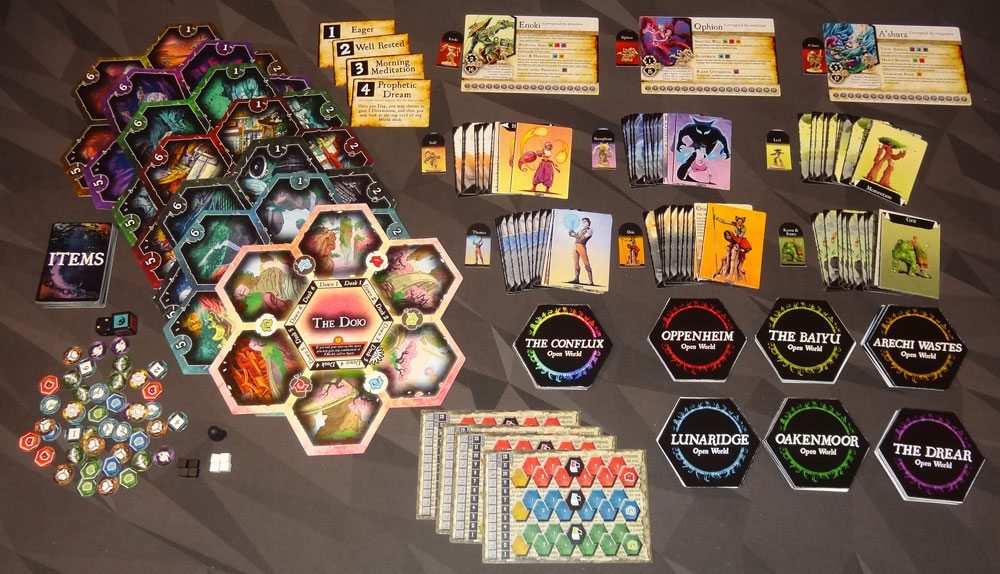
Champions of Hara Components
Note that this review is based on a prototype, so it is not representative of final graphics and component quality. (For instance, my copy had cardboard standees instead of plastic miniatures.) The artwork has already gotten an overhaul from Stephen Gibson (of Grimslingers); see the Kickstarter page for the most up-to-date information.
- 7 world boards
- 7 hexagonal world decks (15 cards each)
- 4 player boards
- 3 Corrupted character boards
- 6 player power decks
- 49 Item cards
- 4 Turn Order cards
- 9 character miniatures
- 2 world dice
- 1 Day Tracker meeple
- 7 Health tokens
- 4 Spirit tokens
- 3 Resilience tokens
- 6 Scenario tokens
- 6 Doom tokens
- 12 Spore tokens
I did not get a chance to try the Chaos on Hara expansion so I won’t go into too many details here, but it adds 4 more player characters and 3 more Corrupted characters, including some crossovers from Grimslingers.
First, the world boards are fairly large. Each one is made of six hexes, and you put seven of them together to create the entire board. With that, plus each player’s champion board (and deck of cards and play area), you’ll need a good amount of space to play the game. Add to this the fact that you’ll need room for discard piles for 8 different hexagonal decks and the item deck—though it’s not quite as much as there was in the first iteration of the game.
The artwork on the world boards and cards is nicely done. All of the artwork in the game has a comic book feel to it–and in fact there is a short comic that introduces the world and one of the champions, Thomas Evening. (Chapter 2 introduces Kaoru and Kuma.) The only downside is that because the boards have artwork on every hex but the center (where the corresponding deck is placed), it can be a little overwhelming visually, and it can be hard to tell at a glance which spaces have cards on them and which are empty.
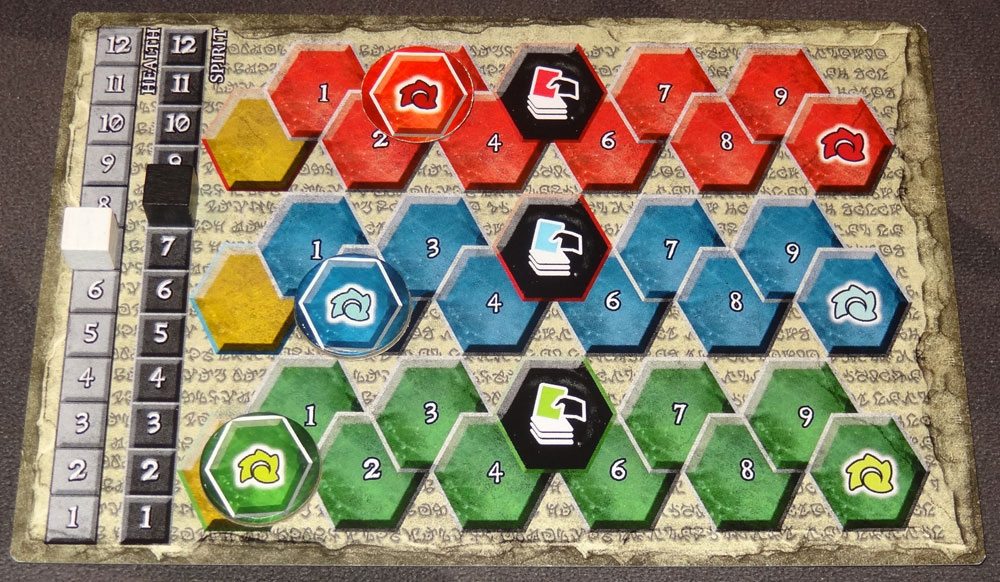
The player boards have changed—there used to be alignment spinners at the top, which affected your moves, but that has been replaced. Now the player board tracks how much of the three types of energy you’ve collected, as well as your Health and your Spirit. Instead of each character having its own player board, the player powers are all on the cards, and the player boards are the same for everyone.
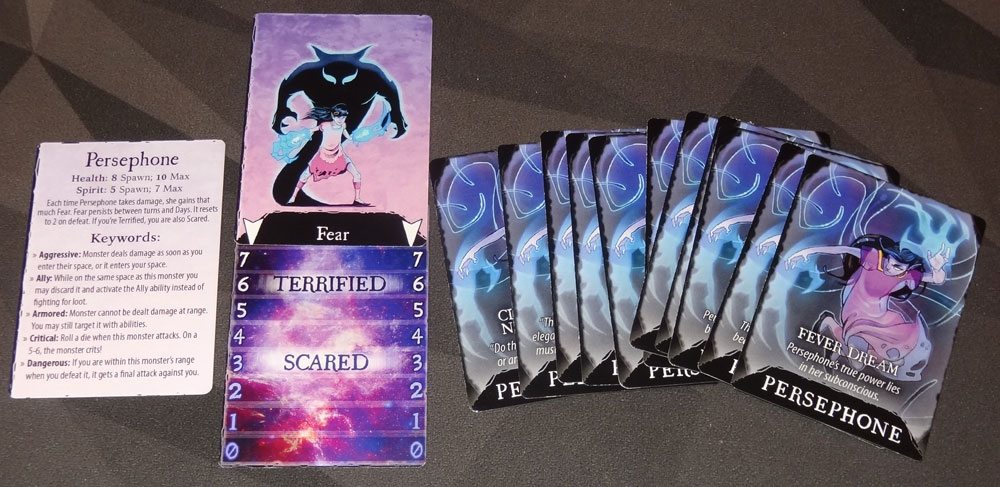
(Prototype shown) Photo: Jonathan H. Liu
Character-specific information is all conveyed on the cards. Each character has an info card showing the starting Health/Spirit, a bit of story about the character, and some keyword reminders as a player aid. Each character also has a resource unique to them, which is tracked with a set of two cards—these come into play with their character ability cards.
There are two six-sided dice. One is a standard die, and the other shows six of the worlds corresponding to the hex boards. (The seventh world is the Dojo, and since nothing spawns there, it is not represented on the die.)
The Corrupted character boards are new, and are used for a cooperative scenario, and many of the tokens are used for those scenarios as well.

How to Play Champions of Hara
The Goal
The goal of the standard game is to be first to collect 10 of each energy type (red, blue, and green) and then return to the Dojo. (For a learning game, you can set the goal to 5 of each energy instead.)
There are also additional scenarios with specific rules, but I’ll tell you more about those later. The standard game is the competitive Versus Arena.
Setup

The board is set up with the Dojo tile in the center, with the six worlds placed next to it matching the color icons on the Dojo (and the “1” space placed touching the Dojo). There are two worlds of each color (red, blue, green), and they will be opposite each other on the board. Each world’s deck is shuffled and placed on the center of its board, but alternating between “Open World” and “Hidden Event” cards at the top of each deck, according to the Dojo icons. “Open World” cards will spawn face-up, and “Hidden Event” cards will spawn face-down. The Conflux deck is shuffled and placed to the side; the Item deck is not shuffled and placed to the side.
The day tracker meeple is set on Dawn 1—each day will consist of a Dawn and Dusk.

Each player should take a character board and a character power deck. Find the four starting cards (marked with a sunburst in the corner) and set the rest aside. The character cards will state each player’s starting health and spirit; each player starts with 0 of each energy. Each player also gets one Dreamstone item card. All character miniatures are placed on the Dojo.

Determine the starting player (by who is wearing the most colorful clothes). Then, in clockwise order starting with the first player, each player takes one of the turn order cards. These will determine your player order for that “day” (for two rounds of play), and all of the cards except the first will give you some special ability as well.
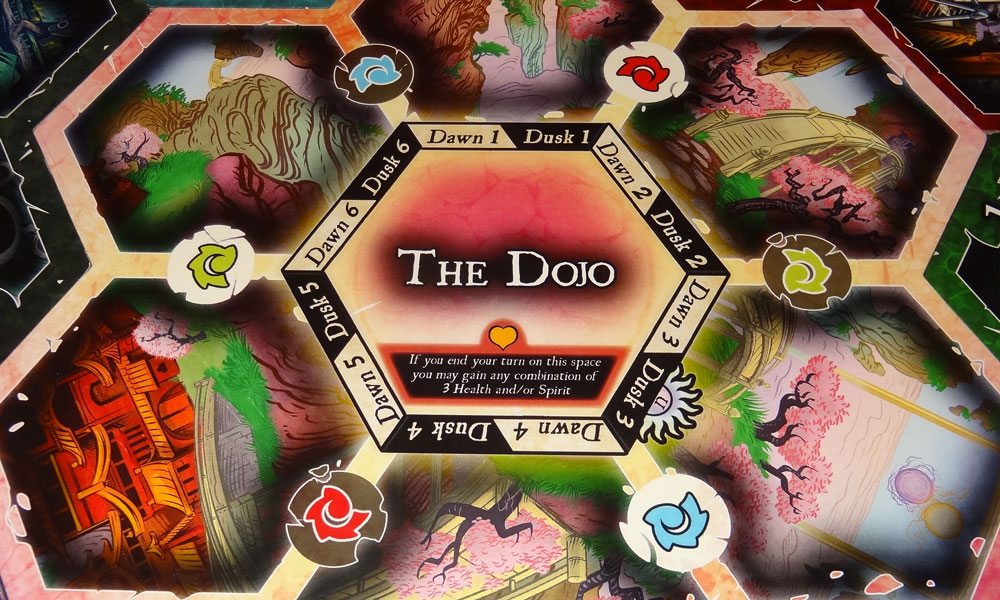
Round Order
Each “day” spans two rounds, Dawn and Dusk. At Dawn, players will rotate the turn order cards and spawn the top card of each world deck onto the space corresponding to the current day. (If the space is already taken, use the lowest available empty space; if the world is filled, do not spawn.) At Dusk, cards are spawned from the Conflux deck—1 plus the number of players—and are placed by rolling the dice to see which world and which space they will go in. Also, at the beginning of Dusk on Day 3, players will add their “Ultimate” power card to their hand.
Activations
In turn order (according to the cards), each player gets to take three “activations,” using cards from their hand or their “board.” As you play cards from your hand, you use the ability on the top half of the card and then place it into an “on board” area on the table. When you use a card from your board, you use the ability on the bottom half of the card and then will return it to your hand at the end of your turn. Note that you can’t use both halves of a card on the same turn. Some cards have a “instant” icon on them and can be played without counting as an activation. There are also some items that are free to use, and the turn order abilities are also free and do not cost an activation.
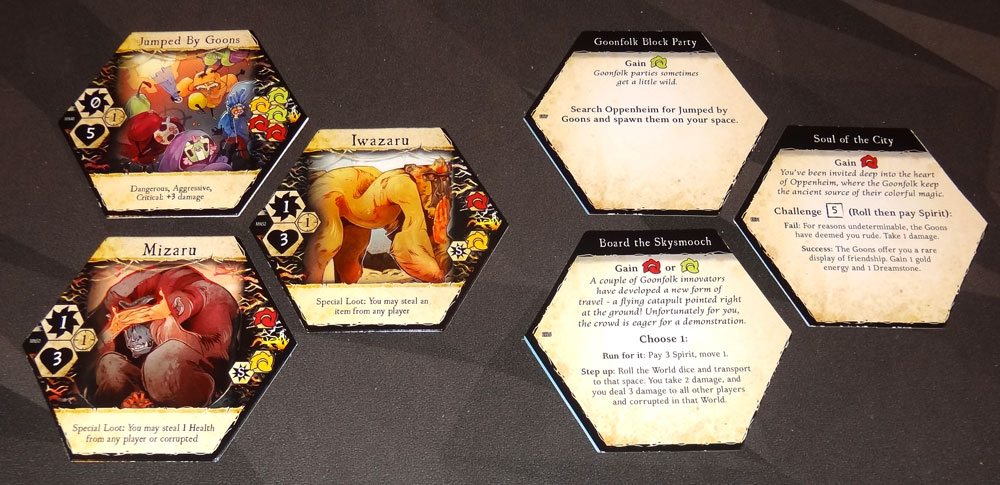
Your cards will allow you to move around the board and attack monsters or other players. As you move, you’ll have to reveal Hidden Event cards as you land on them—they may be events or they might even be hidden monsters. You might find rifts to seal, items to pick up, and encounters that will allow you to choose between various options. Some events will even rearrange the world boards, which can throw a wrench into everyone’s plans. Most of the cards will give you energy of some sort when resolved, which you mark on your player board.
When you fight monsters (or other players), your cards will tell you how much damage you do and what your range is; monsters must be killed on a single turn, because they will heal fully at the end of your turn if you don’t eliminate them. The monsters have various keywords, too: some will damage you when attacked, some have armor that protects them, and so on.
At the end of your turn, when you’re done with your activations, you’ll be attacked by any monsters that have enough range to reach you.
After each player has taken a turn, the round marker advances and the next round begins.
Level Up
When you first collect the 5th energy of a color, you will get to level up. You look through the set-aside power cards and choose one of the matching color, and add it to your hand. During the course of the game you’ll have the opportunity to add three cards (red, blue, green) to your hand—the unchosen ones will no longer be available. (Note that if you lose some energy and then get back to 5, you do not level up again.)
Defeat
If you ever run out of hit points (whether you were attacked by a monster or another player), you respawn in the Dojo, with the health and spirit as indicated on your player card. (If you have enough energy to win, you’ll respawn at a random location instead.) Then, you also lose 2 energy of your choice. When you defeat another player, you get 2 energy of your choice.
Game End
The game ends when somebody is able to collect the necessary energy and return to the Dojo, winning the game.

Scenarios
There will be a few scenarios available—some are fully cooperative, and others are competitive but with some new twists. The scenarios involve the Corrupted—former Champions who have become corrupted and are now seeking their own agendas. Some storylines will work with any Corrupted character, but others will specify one in particular.
If you play in campaign mode, you first play the Versus Arena rules, and then depending on which character won, you will play one of the two scenarios tied to that character’s story.

The Verdict
I first came across Champions of Hara at Gen Con 2014, when I saw the three young men of Leaf Pile Media at a booth in the Entrepreneur Alley. I stopped to chat with them because I was impressed with the artwork they had on display, and although I didn’t get a chance to play the game, I was intrigued and left my card with them, and eventually got a chance to play the prototype. Fast-forward a few years, and they’re now working with Greenbrier Games, which has had several successful Kickstarter campaigns and has seen some tremendous growth in the past few years. Champions of Hara had its timeline set back a little because of continued development, but that development time has resulted in a better game (as well as those plastic miniatures that Kickstarter backers seem to love).
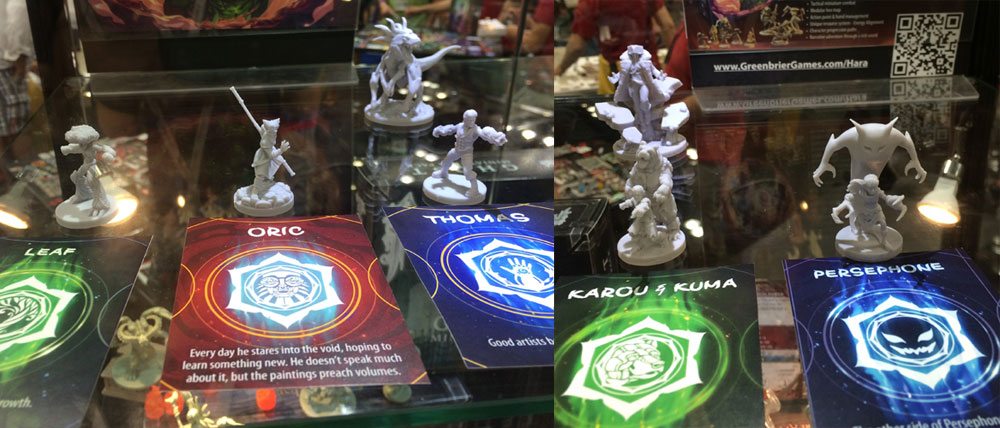
The game, as I said before, looks fantastic—it feels like being in a comic book world, and I really love the way the various characters have their own stories and corresponding abilities. The vivid colors on the board can be a little overwhelming when you’re trying to see all the cards, but I’ve been told that they’re working on making that all easier to parse.
I’m always a fan of asymmetric powers, and Champions of Hara has that in spades. Persephone gains Fear as she takes damage, and her level of fear will power up her abilities. Leaf (okay, let’s just call him Groot, shall we?) builds up Momentum and can knock other players around. Oric has three stances that he switches between, affecting his range and damage or even giving him an additional activation. It’s hard for me to know how well-balanced all these different abilities are after only a few plays, but I like that the characters play differently and that you’ll have to change your tactics based on which characters are in play.
The events that swap world tiles around can be fun or frustrating, depending on where you end up. It can throw you off-guard, separating you from your intended destination or suddenly surrounding you with monsters. The downside of this mechanic is that at times it feels like you’re playing a dexterity game: picking up a hex supporting a deck of cards, several other loose cards, and maybe a few player tokens could be a recipe for disaster. This used to be a regular occurrence as part of the game, but now the rearranging is triggered by certain cards.
I appreciate that there isn’t player elimination–you just respawn, and you lose some progress. But it does feel somewhat funny that you’re all champions trying to save Hara … and beating each other up because each of you wants to be the one champion who saves the world. I do like, however, that the scenarios are then tied to which character wins. Even though the Corrupted characters aren’t just new versions of the player characters, it’s an interesting story to consider that the victor essentially goes crazy with power and then needs to be stopped.

Champions of Hara is fairly long (the estimate of 30–40 minutes per player seems pretty accurate), and it’s one in which a single player’s turn can take a long time if they’ve managed to get extra actions, or particularly if there’s combat or if players are prone to analysis paralysis. I think the half-game is a good starting point, though, to let players get familiar with the rules and the characters, before diving into the full game. That said, if you like longer games, it’s a good mix of tactics and luck. It does get a little fiddly in places, but once you figure out what you’re doing it does flow nicely and there’s a good bit of competition, both direct and indirect. And the artwork is just outstanding.
I know original backers of the game have had a long wait, but the end is finally in sight. I’m confident that if funding is successful, Greenbrier Games will have the ability to turn Champions of Hara into a real winner.
For more information or to make a pledge, visit the Champions of Hara Kickstarter page.
Disclosure: I received a demo prototype of the game for this review.


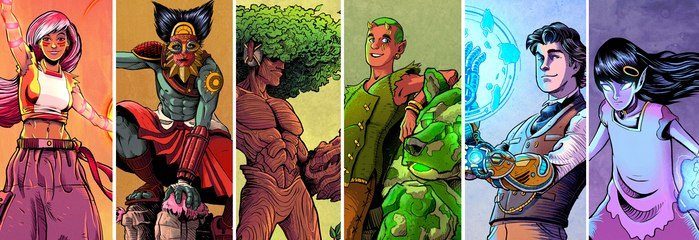




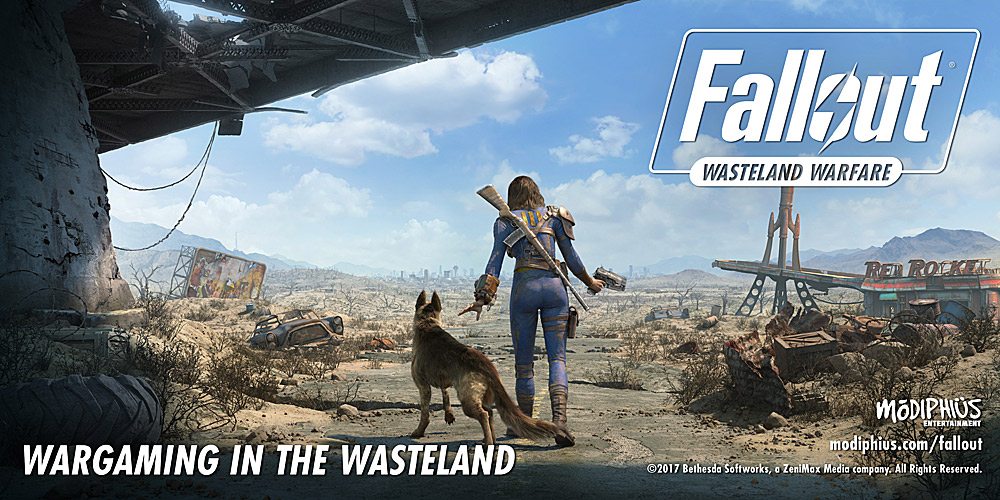
Be careful when dealing with Greenbrier Games. They took my money, ignored me when I told them I hadn’t received the product, tried to steal my money when I told them to make it right and the only think that got me my money back was threatening to report them and call my credit card company to get the charges reversed.
Buyer Beware!